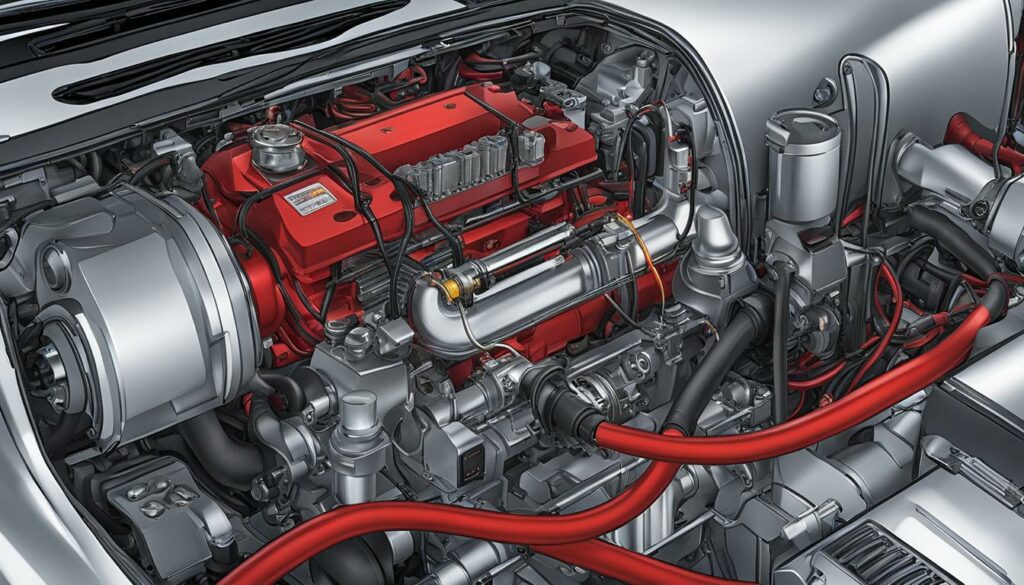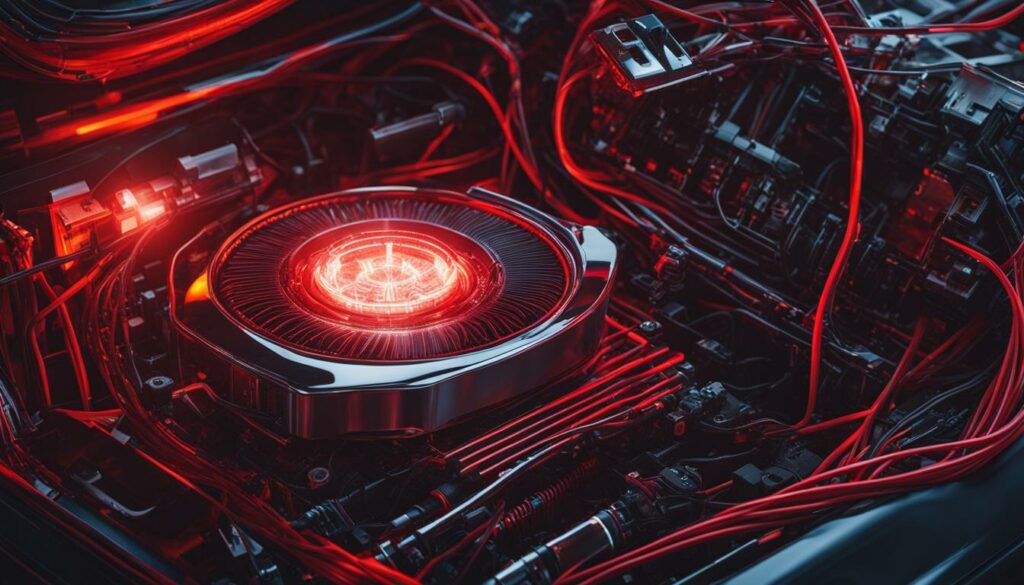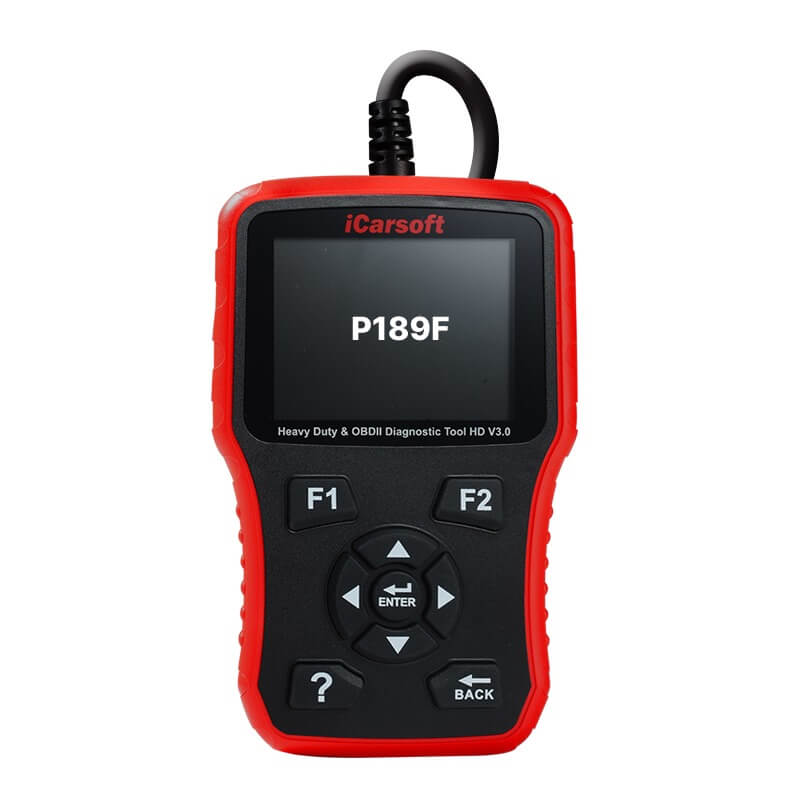P189F – Differential Pressure Sensor B Circuit Current High
POSTED IN pcodes
Welcome to our article on the P189F OBD-II trouble code – Differential Pressure Sensor B Circuit Current High. In this article, we will provide a technical description, meaning, severity, symptoms, common causes, troubleshooting steps, and potential fixes for this code. If you’re experiencing issues with your vehicle and have encountered the P189F code, this article is here to help you understand and address the problem.
Key Takeaways:
- The P189F code indicates a problem with the differential pressure sensor B circuit current being high.
- This issue can lead to a decrease in engine power, reduced fuel efficiency, and the illumination of the check engine light.
- Common causes include a faulty sensor, wiring issues, or a problem with the engine control module (ECM).
- Troubleshooting steps involve checking the wiring and connections, inspecting for exhaust leaks or blockages, and performing tests on the ECM.
- Potential fixes may include repairing or replacing damaged wiring, replacing the differential pressure sensor, or reprogramming/replacing the ECM if necessary.
Symptoms of P189F – Differential Pressure Sensor B Circuit Current High
When the P189F code is present, there are several symptoms that may occur. These can include:
- Decrease in engine power: The vehicle may experience a noticeable decrease in power, resulting in sluggish acceleration and overall reduced performance.
- Reduced fuel efficiency: The engine may consume more fuel than usual, leading to decreased fuel efficiency and potentially higher fuel costs.
- Check engine light illumination: The check engine light on the dashboard may come on, indicating that there is a problem with the vehicle’s emissions system.
- Poor acceleration: When attempting to accelerate, the vehicle may struggle to pick up speed, resulting in slower acceleration than normal.
- Rough idling: The engine may exhibit rough idling, causing the vehicle to vibrate or shake while stationary.
It is important to note that the specific symptoms can vary depending on the make and model of the vehicle. Consulting the vehicle’s service manual or seeking professional assistance can provide more accurate information for a particular vehicle.
Example Scenario:
John was driving his car when he noticed that the engine power had significantly decreased. As he pressed on the accelerator, the car struggled to gain speed and exhibited rough idling when he came to a stop. Concerned, he checked the dashboard and saw that the check engine light was illuminated. Realizing that something was wrong, John decided to have his car diagnosed by a professional technician.
Common Causes of P189F – Differential Pressure Sensor B Circuit Current High
The P189F code can be triggered by various factors, leading to the differential pressure sensor B circuit current being high. Some of the common causes include:
Buy tested tuning file for Adblue / EGR / DPF / Adblue off now!
- Faulty differential pressure sensor: A malfunctioning sensor can provide inaccurate readings or fail to function altogether. This can result in the circuit current being higher than normal.
- Damage or corrosion in the B circuit wiring: Wiring issues, such as damage or corrosion, can disrupt the flow of electrical signals within the circuit. This can cause the circuit current to be unexpectedly high.
- Problem with the engine control module (ECM): The ECM plays a crucial role in monitoring and controlling various components of the engine, including the differential pressure sensor. If the ECM malfunctions or fails to communicate properly with the sensor, it can result in a high circuit current.
- Exhaust leaks: Leaks in the exhaust system can disrupt the pressure readings taken by the differential pressure sensor. This can lead to erroneous readings and trigger the P189F code.
- Clogged or dirty exhaust gas recirculation (EGR) valves: When the EGR valves become clogged or dirty, they can interfere with the proper functioning of the exhaust system. This can impact the readings of the differential pressure sensor and cause the circuit current to be higher than normal.
- Malfunctioning turbocharger: A faulty turbocharger can affect the pressure readings in the exhaust system, leading to an incorrect circuit current reading. This can result in the P189F code being triggered.
Identifying the specific cause of the P189F code requires a thorough diagnosis process. This involves inspecting the differential pressure sensor, checking the condition of the wiring, examining the ECM, and evaluating the overall exhaust system. By addressing the root cause of the code, proper repairs can be made to resolve the issue.

| Common Causes of P189F | Description |
|---|---|
| Faulty differential pressure sensor | A malfunctioning sensor can provide inaccurate readings or fail to function altogether, resulting in a high circuit current. |
| Damage or corrosion in the B circuit wiring | Wiring issues, such as damage or corrosion, can disrupt the electrical signals within the circuit, causing a higher circuit current. |
| Problem with the engine control module (ECM) | A malfunctioning or improperly communicating ECM can lead to a high circuit current in the differential pressure sensor. |
| Exhaust leaks | Leakage in the exhaust system can interfere with the pressure readings of the differential pressure sensor and trigger the P189F code. |
| Clogged or dirty exhaust gas recirculation (EGR) valves | Clogging or dirt in the EGR valves can disrupt the proper functioning of the exhaust system, impacting the differential pressure sensor’s readings and causing a high circuit current. |
| Malfunctioning turbocharger | A faulty turbocharger can affect the pressure readings in the exhaust system, leading to an incorrect circuit current reading and the triggering of the P189F code. |
Troubleshooting Steps for P189F – Differential Pressure Sensor B Circuit Current High
When encountering the P189F code, it is crucial to follow a systematic troubleshooting process to diagnose and resolve the issue. By following these troubleshooting steps, you can effectively identify and rectify the problem.
- Check the Wiring and Connections: Begin by inspecting the wiring and connections associated with the differential pressure sensor. Look for any signs of damage, loose connections, or corrosion. Ensure all connections are secure and properly seated.
- Inspect for Exhaust Leaks or Blockages: Examine the exhaust system for any leaks or blockages that could affect the pressure readings. Pay close attention to the areas near the differential pressure sensor. Repair any leaks or remove any blockages found.
- Perform Tests on the ECM: Use appropriate diagnostic tools to perform tests on the Engine Control Module (ECM). Retrieve any related trouble codes and freeze frame data to gather valuable information on the issue. Analyze the data to gain insights into the root cause of the problem.
- Consult the Vehicle’s Service Manual: If necessary, refer to the vehicle’s service manual for specific troubleshooting instructions and technical details. The manual can provide valuable insights into the diagnostic process and recommended repair procedures.
- Seek Professional Assistance: If the troubleshooting process becomes too complex or if you are unsure about the next steps, consult a professional technician with experience in diagnosing and resolving OBD-II trouble codes. They have the expertise and specialized tools to accurately diagnose and repair the issue.
Following these troubleshooting steps will help you identify the underlying cause of the P189F code and enable you to take appropriate action to resolve the issue. By resolving the problem promptly, you can ensure the optimal performance and efficiency of your vehicle.
Example Quote:
“By systematically checking the wiring, inspecting for leaks, testing the ECM, and referring to the vehicle’s service manual, you can effectively troubleshoot and resolve the P189F code. If needed, don’t hesitate to seek the expertise of a professional technician for a seamless resolution.”
| Troubleshooting Steps | Benefits |
|---|---|
| Check the Wiring and Connections | Ensures proper electrical connectivity and identifies any faults. |
| Inspect for Exhaust Leaks or Blockages | Prevents misleading readings and optimizes sensor performance. |
| Perform Tests on the ECM | Provides valuable data for accurate diagnosis and repairs. |
| Consult the Vehicle’s Service Manual | Offers specific instructions and technical guidance. |
| Seek Professional Assistance | Reliable expertise and access to specialized tools. |
Potential Fixes for P189F – Differential Pressure Sensor B Circuit Current High
The appropriate fix for the P189F code will depend on the specific cause of the issue. In some cases, simply repairing or replacing the damaged wiring or connectors may resolve the problem. If the differential pressure sensor is faulty, it will need to be replaced with a new one. In more complex cases, the ECM may need to be reprogrammed or replaced. It is recommended to consult a professional technician or refer to the vehicle’s service manual for guidance in finding the correct fix for the individual situation.
If you’re experiencing the P189F code, there are a few potential fixes to consider:
- Check and repair damaged wiring: Inspect the wiring and connectors associated with the differential pressure sensor. Look for any signs of damage, such as frayed wires or loose connections. Repair or replace any damaged components as needed.
- Replace the differential pressure sensor: If the sensor is determined to be faulty, it will need to be replaced with a new one. Ensure that you use a compatible sensor for your vehicle’s make and model.
- Reprogram or replace the ECM: In more complex cases, the engine control module (ECM) may need to be reprogrammed or replaced. This should be done by a professional technician who has the necessary expertise and equipment.
Remember, it’s important to diagnose the issue accurately before attempting any repairs. Consulting a professional technician or referring to the vehicle’s service manual can help ensure that you find the correct fix for your individual situation. By addressing the P189F code promptly, you can resolve the issue and restore the proper functioning of your vehicle.

Note: The image above is for illustrative purposes only and may not represent the exact vehicle or component related to the P189F code.
Impact and Severity of P189F – Differential Pressure Sensor B Circuit Current High
The P189F code can have varying impacts and severity depending on the specific circumstances and vehicle. In some cases, the vehicle may experience reduced power and decreased fuel efficiency, which can affect overall performance. If left unaddressed, it can also potentially lead to further damage to components such as the catalytic converter or turbocharger. It is important to address and resolve the code as soon as possible to prevent any further issues and to ensure the proper functioning of the vehicle.
“Addressing the P189F code promptly is crucial to prevent further damage and ensure optimal vehicle performance.”
Professional Assistance for P189F – Differential Pressure Sensor B Circuit Current High
If the troubleshooting and repair processes for the P189F code seem too complex or difficult, it is always recommended to seek professional assistance. Automotive technicians with experience working on diagnostic trouble codes can provide the necessary expertise and professional support to accurately diagnose and fix the issue.
These technicians have access to specialized tools and equipment that can aid in the diagnostic process, ensuring an accurate assessment of the problem. Additionally, they stay updated with the latest technical resources and service manuals specific to various makes and models of vehicles. This knowledge and access to resources can greatly enhance the diagnosis and repair process.
Consulting a trusted professional technician will not only save you time and effort but also increase the likelihood of resolving the P189F code efficiently. They will perform a thorough analysis of the differential pressure sensor B circuit current high issue and devise a targeted repair plan.
“Seeking professional assistance can provide the peace of mind knowing that the problem will be properly diagnosed and resolved, helping to avoid further damage and restoring the optimal functioning of your vehicle.”
Professional technicians are well-versed in the intricacies of automotive electronics and have the experience to handle complex diagnostic trouble codes like P189F. They possess the necessary expertise to interpret diagnostic data, identify potential underlying causes, and implement effective repair solutions. By relying on their professional assistance, you can reduce the risk of misdiagnosis and ensure a reliable and long-lasting repair for your vehicle.
Remember, the P189F code can have various causes, ranging from faulty sensors to wiring issues or problems with the engine control module (ECM). To accurately diagnose and fix the issue, professional assistance can make a significant difference.
Even if you have some knowledge and experience with automotive repairs, the complexity of the P189F code warrants professional attention. Technicians who specialize in diagnostic trouble codes can provide an in-depth analysis and accurate solution to the problem, ultimately saving you time, money, and frustration.
When you face the P189F code, don’t hesitate to seek professional assistance. Consulting an experienced automotive technician will lead you closer to a reliable diagnosis and repair, ensuring the smooth and efficient operation of your vehicle.
Conclusion
To conclude, the P189F OBD-II trouble code signifies an issue with the differential pressure sensor B circuit’s current being high. This problem can have adverse effects on the vehicle’s performance and efficiency and should be addressed promptly to prevent further complications. By diligently following the recommended troubleshooting steps and seeking the assistance of professionals when necessary, it is possible to accurately diagnose and rectify the root cause of the code. Implementing the appropriate repairs will not only restore the proper functioning of the vehicle but also prevent any potential damage from occurring.
Ensuring the differential pressure sensor B circuit’s current is within the specified range is crucial for maintaining optimal engine performance. Ignoring the P189F code can lead to decreased power, compromised fuel efficiency, and potential harm to essential components such as the catalytic converter and turbocharger. Thus, it is vital to take the necessary measures to mitigate these risks.
In summary, if you encounter the P189F code, promptly address the issue by adhering to the troubleshooting steps outlined in this article. However, keep in mind that some repair procedures may require professional guidance, particularly when dealing with complex electronic systems. By taking proactive measures and resolving the P189F code, you can secure the reliability and longevity of your vehicle.
FAQ
What does the P189F code mean?
The P189F code refers to the differential pressure sensor B circuit current being high. It indicates a problem with the circuit that monitors the differential pressure sensor in the exhaust system.
What are the symptoms of the P189F code?
Symptoms of the P189F code can include a decrease in engine power, reduced fuel efficiency, the illumination of the check engine light, poor acceleration, and rough idling.
What are the common causes of the P189F code?
Common causes of the P189F code include a faulty differential pressure sensor, damaged or corroded wiring in the B circuit, or an issue with the engine control module (ECM).
What are the troubleshooting steps for the P189F code?
Troubleshooting steps for the P189F code may include checking the wiring and connections associated with the differential pressure sensor, inspecting for exhaust leaks or blockages, and performing tests on the ECM.
What are the potential fixes for the P189F code?
The appropriate fix for the P189F code will depend on the specific cause of the issue. It may involve repairing or replacing damaged wiring or connectors, replacing the differential pressure sensor, or reprogramming or replacing the ECM.
What is the impact and severity of the P189F code?
The impact and severity of the P189F code can vary depending on the circumstances and vehicle. It can result in reduced power, decreased fuel efficiency, and potentially damage components such as the catalytic converter or turbocharger.
When should I seek professional assistance for the P189F code?
If the troubleshooting and repair processes seem too complex or difficult, it is recommended to seek professional assistance. Automotive technicians with experience working on diagnostic trouble codes can accurately diagnose and fix the issue.


